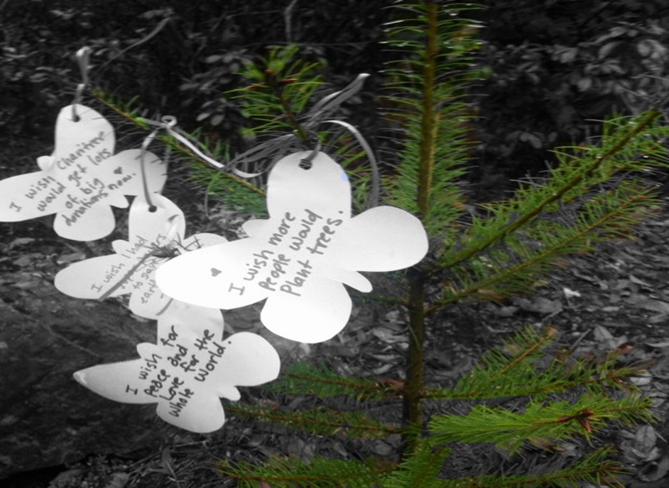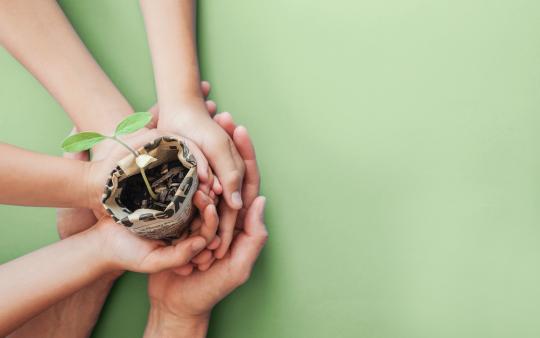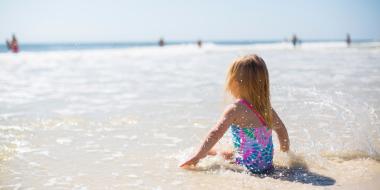When is the right time to talk to your kids about climate change? The answer is simple: the time is now. According to Tzeporah Berman, environmentalist, author, and the international program director of Stand.Earth, “Climate change is the greatest threat facing humanity today and our kids will hear about it in school, on the news and from friends so I think it's critical that we talk to them about it.” While it may feel like something that you can push to the periphery or leave until your child is older, the reality is that they—like millions of other children and youth around the world—are directly impacted by climate change each day.
Sixteen-year-old climate activist Poppy Stowell-Evans, chair of the Youth Climate Ambassadors for Wales, is ready to change the world, and grateful her parents are open to answering her questions and talking about global issues like climate change. “It is important to discuss the climate with your family because this is an issue that we can positively impact as individuals.” Stowell-Evans says. “The action we take does count! By having these discussions, you're showing your child the power that they can have and informing them that they can make a positive difference and actually change the world. Trust me, as a young person, that's the best feeling ever!”
Planting the seeds of change
With the surge in anxiety among children and teens in the wake of the global pandemic, many parents are afraid to talk to their kids about climate change-related natural disasters because they don’t want to make them feel even more anxious. However, Berman asserts that this just isn’t the case. “There is an old adage that as a parent I find true, that children learn what they live. If they are not hearing about [climate change] at home, I think it's hard for them to process, and it reinforces the disconnect that studies show increases anxiety—if it's such a huge threat, why is no one talking about it or acting like it is?”
Stowell-Evans also notes that it is young people who are the driving force behind climate activism. “I think that we've seen in the last 5 years a massive raise in awareness of climate change and climate action and this has primarily been driven by young people,” she says. “We have also seen more young people become more engaged. Young people have created such a powerful, inspirational and strong voice proving our conviction for change and ultimately that wouldn't have happened if climate anxiety had not risen.”
To help lower the stress and fear that may arise when talking about the climate crisis—what might be called “climate anxiety” or “eco anxiety”—zero in on problem-solving actions you and your kids can take now to help the world. Point out good news when you hear it and provide examples of the many good people around the world working hard every day to help the planet.
As parents, we want to build hope. When we choose to inspire and empower our children to become environmental stewards and leaders, they will be more confident and capable of facing the future.
Growing a global citizen
Climate change is a complex issue and, as parents, we can sometimes feel helpless and overwhelmed by the magnitude of the problem. While it is important to convey the realities of the climate emergency, it is essential for children and teens to learn a non-alarmist, science-based understanding of climate change. It's also important to talk about climate change solutions and what we all can do to help.
Get Outdoors
Introduce your kids to the wonders of nature. Give your kids opportunities to fall in love with nature—after all, you protect what you love. Enroll your children in outdoor education opportunities like summer camps, and introduce them to fun nature-based activities, like learning to identify trees on a local nature walk.
Be Relatable
Berman says she tries to find examples of good laws and exciting new technologies to talk about with her kids. “My boys and I have looked online at new electric trucks, cool solutions like repurposing fossil fuel infrastructure in the Netherlands for renewables, and I have pointed out huge new solar installations or big announcements like banning the fossil fuel car,” she says. “I don't dodge their hard questions about the increase in fires or floods, but I do talk about how quickly the world is changing and how much can be done.”
Appeal to Age
Factor in your children’s ages and personalities when talking about climate change. Hands-on activities and visuals like photos and videos, or day trips out in the world to see examples first-hand fosters an environment of curiosity and exploration, and provides a safe space for asking questions and positing ideas.
Take the Lead
Kids are more likely to value and connect with nature when they see their parents, teachers, and friends having fun in the outdoors.
Be a Good Listener
It is so important for kids to feel heard. Slow down and take the time to answer their questions—if you’re not sure of the answer yourself, let them know that you don’t know, but you’ll find out and then do some online research or ask an expert. That way you are better able to provide a thoughtful, educated manner.
Let Your Kids Teach
Don’t underestimate what your kids already know about climate change, and be willing to listen to what they have to say. Kids learn so much outside of the home and are constantly observing changes happening to our planet. For example, if your child learns something new about recycling at school, let them teach you what they learned and incorporate it into your daily routine. Make it fun and give them credit for helping your family and the world. Outstanding teen activists, like Stowell-Evans and Greta Thunberg, remind us that kids can do anything!
Take Action
If your child wants to take action, join in and help them. Encourage them to join a protest march, use their voices, and share their feelings about climate change. Let them create an environmental campaign and join in to help them. You can also introduce older kids and teens to great books about activism like 50 Simple Things Kids Can Do to Save The Earth and It’s Your World: Get Informed, Get Inspired, and Get Going!
Plant a Wish Tree
If your budding climate activist wants to learn about trees and soil erosion, get hands-on and plant a wish tree. The idea, inspired by The Wish Trees: How Planting Trees Can Help Make the World a Better Place, encourages kids to plant a local tree seedling and then make a wish for the world. Then, each time they return to visit and/or care for their tree they can make more wishes! Trees do so many tree-mendous things and planting a tree provides an excellent opportunity to share their importance with your children. Whether or not you dress up the tree with handprinted wishes or just speak them with your mind, doing something hopeful, like planting a tree, is a great way to encourage little ones to take pride in their contribution and take part in the world around them.

“I wish for a happy and healthy planet, so it can be there for generations to enjoy.” — Kiana
“I wish kids everywhere could unite to fight climate change before it is too late for us and future generations.” — Holden
“I wish I had super powers to save the earth and save people.” — Aiden
You may also enjoy: Raising Kind Children Through Environmental Sustainability, Supporting Your Child's Environmental Activism, and How to Teach Children to Care About the Environment.






